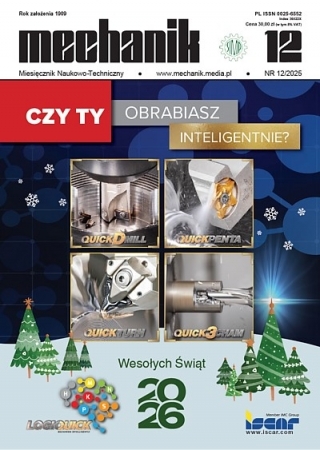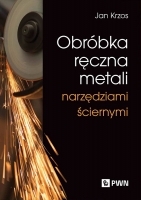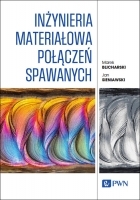Diagnostyka stanu narzędzi i procesu skrawania *
Tool and process condition monitoring
Mechanik nr 07/2017 - Organizacja produkcji
STRESZCZENIE: Automatyczna diagnostyka stanu narzędzi i procesu skrawania jest oparta na pomiarach wielkości fizycznych skorelowanych z tym stanem. Z każdego sygnału da się wyznaczyć bardzo wiele miar i nie można przewidzieć, które z nich będą przydatne w określonym przypadku. Miary te muszą być zatem wybierane automatycznie, a następnie integrowane w jedno oszacowanie stanu, np. z wykorzystaniem metod sztucznej inteligencji.
SŁOWA KLUCZOWE: diagnostyka stanu narzędzia, obróbka sygnałów
ABSTRACT: Automatic tool condition monitoring is based on the measurements of physical phenomena which are correlated with this condition. There are numerous signal features (SFs) that can be extracted from the signal. As it is really not possible to predict which signal features will be useful in a particular case they should be automatically selected and combined into one tool condition estimation. This can be achieved by various artificial intelligence methods.
KEYWORDS: tool condition monitoring, signal processing
BIBLIOGRAFIA / BIBLIOGRAPHY:
- Al-Habaibeh A., Gindy N. “A new approach for systematic design of condition monitoring systems for milling processes”. Journal of Materials Processing Technology. 107 (2000): s. 243–251.
- Binsaeid S., Asfoura S., Chob S., Onarc A. “Machine ensemble approach for simultaneous detection of transient and gradual anomalies in milling using multisensor fusion”. Journal of Materials Processing Technology. 209 (2009): s. 4728–4738.
- Błażejak K., Bombiński S., Nejman M., Jemielniak K. “Sensor signal segmentation for tool condition monitoring”. Procedia CIRP. 46 (2016): s.155–160.
- El-Wardany T.I., Gao D., Elbestawi M.A. “Tool condition monitoring in drilling using vibration signature analysis”. International Journal of Machine Tools and Manufacture. 36 (1996): s. 687–711.
- Halgamuge S.K., Glesner M. “NNs in designing fuzzy systems for real world applications”. Fuzzy Sets and Systems. 65 (1984): s. 1–12.
- Jemielniak K. „Automatyczna diagnostyka stanu narzędzia i procesu skrawania”. Warszawa: Oficyna Wydawnicza Politechniki Warszawskiej, 2002.
- Jemielniak K. “Tool wear monitoring based on a non-monotonic signal feature”. J. Engineering Manufacture. Part B. 220, 2 (2006): s. 163–170.
- Jemielniak K., Bombiński S. “Hierarchical strategies in tool wear monitoring”. Proc. IMechE. 220/B (2006): s. 375–381.
- Jemielniak K., Kossakowska J., Urbański T., Bombiński S. “Tool condition monitoring based on numerous signal features”. International Journal of Advanced Manufacturing Technology. 59 (2012): s. 73–81.
- Li X. “A brief review-acoustic emission method for tool wear monitoring in turning”. International Journal of Machine Tools and Manufacture. 42 (2002): s. 157–165.
- Li X., Ouyang G., Liang Z. “Complexity measure of motor current signals for tool flute breakage detection in end milling”. International Journal of Machine Tools and Manufacture. 48 (2008): s. 371–379.
- Marinescu I., Axinte D. “A time-frequency AE-based monitoring technique to identify workpiece surface malfunctions in milling with multiple teeth cutting simultaneously. International Journal of Machine Tools and Manufacture. 49 (2009): s. 53–65.
- Peng Y. “Empirical model decomposition based time-frequency analysis for the effective detection of tool breakage”. Journal of Manufacturing Science and Engineering. 128, 1 (2006): s. 154–166.
- Salgado D., Alonso F. “Tool wear detection in turning operations using singular spectrum analysis”. Journal of Materials Processing Technology. 171 (2006): s. 451–458.
- Quan Y., Zhoub M., Luo Z. “On-line robust identification of tool wear via multi-sensor NN fusion”. Engineering Applications of Artificial Intelligence. 11 (1998): s. 717–722.
- Scheffer C., Heyns P.C. Wear monitoring in turning operations using vibration and strain measurements”. Mechanical Systems and Signal Processing. 15, 6 (2001): s. 1185–1202.
- Scheffer C., Heyns P.C. “An industrial tool wear monitoring system for interrupted turning”. Mechanical Systems and Signal Processing. 18 (2004): s. 1219–1242.
- Shi D., Gindy N.N. “Tool wear predictive model based on least squares support vector machines”. Mechanical Systems and Signal Processing. 21 (2007): s. 1799–1814.
- Sick B. “On-line and indirect tool wear monitoring in turning with artificial neural networks: a review of more than a decade of research”. Mechanical Systems and Signal Processing. 16, 4 (2002): s. 487–546.
- Sun J., Hong G.S., Rahman M., Wong Y.S. “Identification of feature set for effective tool condition monitoring by AE sensing”. International Journal of Production Research. 42, 5 (2004): s. 901–918.
- Teti R., Jemielniak K., O’Donnell G., Dornfeld D. Advanced monitoring of machining operations (keynote paper). CIRP Annals – Manufacturing Technology. 59, 2 (2010): s. 717–739.
- Teti R., Kumara S.R.T. “Intelligent computing methods for manufacturing systems”. STC-O KN Paper. CIRP Annals. 46/2 (1997): s. 629–652.
Pobierz plik / download
PL: Krzysztof Jemielniak: Diagnostyka stanu narzędzi i procesu skrawania (PDF, ~1,4 MB)
ENG: Krzysztof Jemielniak: Tool and process condition monitoring (PDF, ~1,3 MB)




















